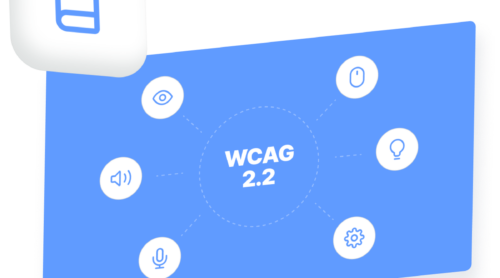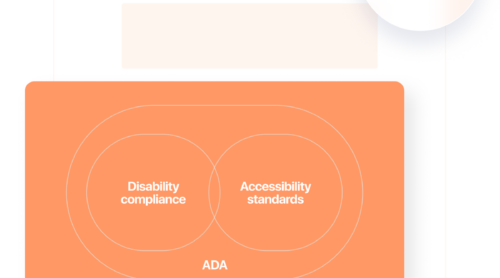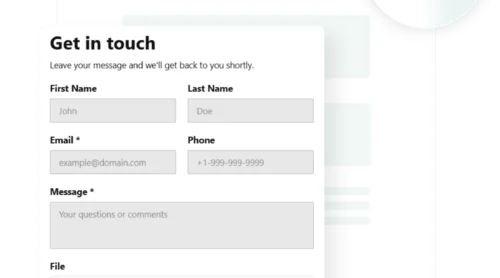Why Web Accessibility Matters
Website accessibility requirements have become a fundamental part of how organizations structure their online presence. Accessibility is no longer optional — it directly impacts user experience, legal compliance, and a brand’s public image. A website that isn’t inclusive risks not only alienating users but also violating established standards.
To meet modern accessibility expectations, websites must implement specific technical and content-oriented practices that support users with a range of disabilities. Some of the most critical elements include:
- Clear structure and semantic HTML. Proper use of headings, lists, and HTML5 elements helps screen readers interpret and navigate content accurately.
- Keyboard-friendly navigation. All interactive elements — such as menus, forms, and buttons — should be accessible using only a keyboard, without requiring a mouse.
- Descriptive link text and accessible forms. Links should clearly describe their destination (e.g., “Download accessibility checklist” instead of “Click here”), and forms must include properly labeled input fields with visible and assistive-friendly error handling.
- Media alternatives like transcripts or captions. Videos and audio content should include synchronized captions or full transcripts so users with hearing impairments can access the information equally.
The push for inclusivity in web design is not just driven by ethics — it’s grounded in real-world benefits. Accessible websites often outperform their competitors in usability, retention, and even SEO. Additionally, aligning with equal access legislation from the beginning saves businesses from reactive overhauls later.
Let’s have a closer look at various disability compliance laws that apply to websites and other digital platforms.
Key Accessibility Laws
Whether your audience is local or international, understanding the legal obligations behind website accessibility laws is critical. A growing number of countries are introducing strict regulations to enforce equal digital access. These rules define what accessible means, when compliance is required, and who is held accountable.
While most laws are modeled around the Web Content Accessibility Guidelines (WCAG), they differ in how and when they apply. Below is a summary of major legal policies influencing how accessibility is governed worldwide:
Major Accessibility Laws by Region
| Law Name | Region | Who It Applies To | When It Applies | Scope | Enforcement Notes |
|---|---|---|---|---|---|
| ADA (Americans with Disabilities Act) | United States | Public and private businesses offering goods or services | At all times, regardless of size or online traffic | Requires websites to be accessible to people with disabilities under Title III | Enforced via civil lawsuits and Department of Justice actions |
| Section 508 (Rehabilitation Act) | United States | Federal agencies and organizations receiving federal funding | Ongoing; applies during development and procurement | Requires electronic and IT systems to meet WCAG 2.0 Level AA | Audits, procurement restrictions, and federal compliance reviews |
| AODA (Accessibility for Ontarians with Disabilities Act) | Canada (Ontario) | Private and non-profit organizations with 50+ employees | Phased deadlines from 2014 to 2025, based on organization type | Mandates WCAG 2.0 compliance for all web content and apps | Inspections, monetary penalties, and published violations |
| EAA (European Accessibility Act) | European Union | Businesses offering digital goods or services across EU | Fully enforced on June 28, 2025 | Covers websites, apps, e-commerce, banking, e-books, and more | Enforced by national authorities with EU-wide harmonization |
| UK Equality Act 2010 | United Kingdom | All organizations providing digital services to the public | Applies continuously, regardless of organization size | Prohibits discrimination against people with disabilities, including digital barriers | Individuals can bring claims directly to civil court |
| EN 301 549 | European Union | Public sector bodies and their digital vendors | Applies to all new procurement contracts since 2018 | Sets detailed accessibility standards for ICT products and services | Non-compliance may lead to contract rejection or penalties |
Legal expectations are no longer vague or voluntary. These policies form the backbone of accessibility policy enforcement, and failure to comply can lead to lawsuits, contract losses, and damage to brand trust. Preparing now is far less costly than reacting later.
ADA Digital Accessibility Requirements
In the United States, one of the most referenced and enforced website accessibility laws is the Americans with Disabilities Act (ADA). Although the ADA was enacted in 1990 — well before the modern internet — it has since been interpreted by courts and the Department of Justice to include websites and digital services under its protection, particularly those of businesses considered “places of public accommodation”.
Is Website Accessibility Legally Required for Businesses?
Yes. According to current government accessibility guidelines, digital accessibility is a legal requirement for most U.S. businesses — especially if they sell products, offer services, or interact with the public online. ADA digital compliance expectations have intensified in recent years, with thousands of lawsuits filed annually over inaccessible websites.
The legal foundation for enforcement is not limited to large corporations. Small and medium-sized businesses are frequently targeted in lawsuits, especially in industries like eCommerce, hospitality, education, and healthcare. If your website offers public-facing services, you are subject to legal obligations for online platforms under ADA compliance.
- WCAG Adoption: The DOJ recommends WCAG 2.1 Level AA as the benchmark for digital accessibility.
- No Exceptions for Size: Businesses of all sizes are expected to comply — even sole proprietors.
- ADA Lawsuits: Plaintiffs do not need to prove intent — only that barriers exist that hinder equal access.
While there is no federal certification or seal for ADA compliance, implementing recommended accessibility practices protects your business from legal risks and demonstrates a strong commitment to digital inclusion. Proactively meeting accessibility standards is not only safer — it’s also better for user experience and SEO performance.
- WCAG 2.1 Level AA compliance: While not codified, the DOJ recognizes it as the standard benchmark for accessibility.
- Keyboard-accessible navigation: All functionality must be available without the use of a mouse.
- Alternative text for images: All non-text content must include descriptive alt attributes.
- Readable color contrast: Text must meet contrast ratios to ensure visibility for users with visual impairments.
- Accessible forms: Input fields need clear labels, instructions, and error identification.
- Skip navigation links: Allow screen reader users to bypass repeated elements.
- Semantic HTML structure: Use proper headings and elements to create logical page flow.
- Screen reader compatibility: Elements should be properly announced, using ARIA roles if necessary.
- Captions and transcripts: Videos must include captions; audio-only content must have transcripts.
- Inclusive interaction design: Avoid visual or functional barriers that prevent equal access.
EAA Website Compliance Requirements
The European Accessibility Act (EAA) is one of the most comprehensive website compliance laws ever introduced in the EU. Enforced across all member states, the EAA aims to harmonize accessibility requirements for digital products and services. It places strong emphasis on websites, mobile applications, and ecommerce platforms, making compliance essential for any business serving EU customers.
Unlike U.S.-based ADA laws that were built around physical spaces and expanded to include the web, the EAA was created with digital accessibility in mind from the outset. It sits within a broader regulatory framework for websites in the EU, aligning with WCAG standards and enforcing uniform accessibility across member nations.
How Does the EAA Differ from the ADA?
| Aspect | ADA (United States) | EAA (European Union) |
|---|---|---|
| Jurisdiction | Applies to U.S.-based businesses offering public-facing services. | Applies to any business selling digital products or services in the EU market. |
| Scope | Covers websites, often interpreted through court rulings and DOJ guidance. | Includes websites, mobile apps, e-books, banking services, ticketing systems, and self-service terminals. |
| Enforcement | Enforced via civil lawsuits and Department of Justice actions. | Enforced by national authorities with penalties, inspections, and public notices. |
| Clarity | Broad legal language with evolving interpretations through litigation. | Provides clear deadlines and categories for compliance across all member states. |
Businesses falling under website compliance requirements in the EU should begin auditing their accessibility readiness now. Preparing early ensures smoother integration with WCAG 2.1 or 2.2 standards and avoids last-minute disruptions to operations
- WCAG 2.2 Level AA requirement: Clearly mandated across all covered digital services and platforms.
- Mobile app accessibility: Apps must meet the same accessibility criteria as websites.
- Accessible digital documents: Files like PDFs must be readable by screen readers and assistive technologies.
- Consistent user interface: Websites should follow predictable navigation and layout patterns.
- Customizable display options: Users should be able to adjust text size, contrast, and spacing.
- Declared language attributes: Pages must specify language for assistive tech accuracy.
- Public accessibility statement: Websites must publish compliance declarations and contact methods.
- Accessible support channels: Customer service interfaces must be operable by people with disabilities.
- Coverage for self-service terminals: Kiosks and similar interfaces connected to digital services must be accessible.
- Monitoring and feedback procedures: Businesses must track compliance and respond to public complaints.
What Happens If You Don’t Comply
Ignoring website compliance requirements is no longer a low-risk gamble. With stronger enforcement policies and more legal precedents globally, failing to meet accessibility standards can result in financial, legal, and reputational consequences. Whether due to oversight or lack of preparation, organizations that overlook their obligations open themselves to avoidable liabilities.
Governments, advocacy groups, and individuals are all increasingly empowered to take action when websites fail to meet legal obligations for online platforms. Enforcement is not limited to major corporations — small businesses, nonprofits, and educational institutions have also faced serious penalties.
Consequences of Non-Compliance
| Type of Penalty | Details & Examples |
|---|---|
| Financial Fines | Non-compliant websites can incur fines ranging from a few thousand to hundreds of thousands of dollars depending on the law and region. |
| Lawsuits & Settlements | Thousands of ADA-related lawsuits are filed each year in the U.S. alone, many of which result in costly legal settlements. |
| Public Exposure | Violations are often made public by watchdog groups, which can damage brand reputation and erode customer trust. |
| Loss of Government Contracts | For vendors and partners working with public sector bodies, failure to meet compliance can lead to revoked contracts or disqualification from bidding. |
| Operational Disruption | Legal action may require emergency remediation of digital content, leading to development delays and resource strain. |
Governments and regulatory agencies enforce these rules through audits, user complaints, and legal channels. The cost of non-compliance often outweighs the investment needed for proactive accessibility improvements, especially as accessibility breach penalties continue to grow in scope and severity.
Steps to Make Your Website Compliant
Becoming compliant with website accessibility requirements is a multi-phase process that blends design, development, testing, and ongoing maintenance.
- Conduct an Accessibility Audit: Use automated tools and manual testing to identify accessibility barriers. Look for issues in navigation, media, text alternatives, and contrast ratios.
- Follow WCAG Guidelines: Implement updates based on the Web Content Accessibility Guidelines (WCAG) 2.1 or 2.2, with Level AA as the minimum recommended standard.
- Use Semantic HTML: Structure your content using clear HTML markup with proper use of headings, ARIA labels, and alt attributes.
- Enable Keyboard Navigation: Ensure that all interactive components — menus, modals, forms — can be used without a mouse.
- Provide Media Alternatives: Add captions to videos, transcripts to audio, and text descriptions for infographics or charts.
- Train Your Team: Educate content creators, developers, and designers on best practices for inclusivity in web design.
- Establish an Accessibility Policy: Publish a public-facing accessibility statement and provide a contact method for feedback or assistance.
The most effective accessibility strategies begin early in the design process and are reinforced by continuous monitoring. Prioritizing accessibility improves not just legal standing but also usability, SEO performance, and brand reputation across all user groups.
Use a Widget to Streamline Accessibility
For website owners looking for a fast, effective way to improve accessibility, using a ready-made solution like the Elfsight accessibility widget can make a big difference. This widget allows users to adjust font sizes, contrast, spacing, and other visual settings, making content easier to perceive and navigate without overhauling your website design.
Step-by-step instructions:
- Pick a Starting Template. Once inside the Accessibility widget builder, you’ll be asked to begin with a template. Choose the preset Accessibility Template and hit “Continue with this template” to proceed.
- Perform a Website Audit. Head to the “Check” section and input your website address. The tool, powered by Google Lighthouse, will assess your page and highlight issues based on ARIA roles and labels as well as general EAA compliance gaps.
- Fine-tune Widget Preferences. Navigate to the “Settings” area to adjust parameters like language, page visibility, device targeting, and side positioning. You’ll also have the option to use your own CSS or JavaScript for deeper customization.
- Install the Widget Code. Click on “Add to website for free” at the bottom of the editor. Copy the code displayed under the “Embed Code” tab, then open your website editor and paste the snippet where you want the widget to display.
As soon as the code is embedded, the accessibility enhancements go live, ensuring your visitors enjoy an optimized and barrier-free experience across your entire website.
The widget can be added to nearly any platform — including HTML, WordPress, Wix, Shopify, and more — giving businesses a head start toward compliance while improving the browsing experience for users with disabilities. While a widget should not be the only step taken, it’s a smart enhancement that complements broader accessibility efforts.
Try building your own widget – make your website accessible to all!
Frequently Asked Questions
What happens if my website uses third-party content that isn’t accessible?
How often should I update or review my website’s accessibility?
Is accessibility only relevant to users with permanent disabilities?
Can I be sued even if I didn’t know my website wasn’t accessible?
Do accessibility improvements affect SEO?
Conclusion
As you’ve seen throughout this guide, ensuring your website meets accessibility requirements is not just a legal checkbox — it’s a commitment to inclusivity, usability, and future-readiness. From ADA regulations in the U.S. to the upcoming enforcement of the EAA across the EU, laws around the world are converging on the same principle: digital content must be usable by everyone.
Taking action now — through audits, compliance frameworks, and tools like the Elfsight ADA Compliance widget — can help you avoid costly penalties, improve your search visibility, and serve a broader audience. Accessibility is not a trend or temporary initiative; it’s a permanent responsibility. By building and maintaining an accessible website, you’re creating a better web for everyone.






